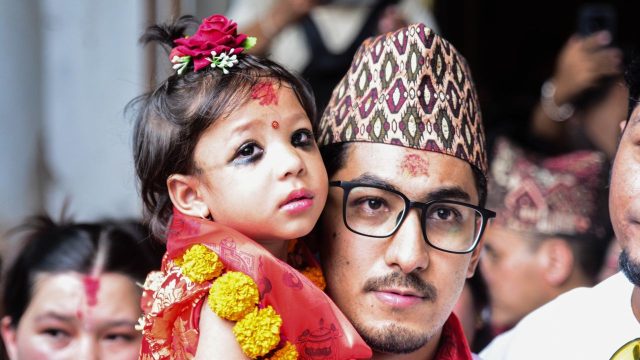
“She was just my daughter yesterday, but today she is a goddess.” So said the father of Aryatara Shakya, the two-year-old proclaimed Nepal’s new “living goddess”. Carried by family members from their home to a temple palace in Kathmandu, the toddler was installed as the latest Kumari last week during the country’s most significant Hindu festival, Dashain.
“My wife during pregnancy dreamed that she was a goddess,” Ananta Shakya told The Associated Press, “and we knew she was going to be someone very special.”
The secret life of a Kumari
In a tradition stretching back 300 years, the Kumari is revered by both Hindus and Buddhists in Nepal and parts of India as an embodiment of the divine female energy. Chosen from the Shakya clan, Newari Buddhists indigenous to the Kathmandu valley, the girls are typically aged between two and four, and must meet strict physical criteria: “unblemished skin, hair, eyes and teeth”, said AP. During festivals, the Kumari is “wheeled around on a chariot pulled by devotees”, dressed in red and with a “third eye” painted on her forehead.
“But no one really knows what happens on the induction day,” said the ABC – “not even the Kumari herself, being too young to remember.” The girls spend most of their childhood sequestered within the temple, although traditions have evolved to include some private tutoring. They are rarely allowed outside – beyond the temple walls, their feet are not allowed to touch the ground.
Former Kumari Preeti Shakya held the position for eight years, before “returning to an anonymous suburban life” at the age of 11. During her time inside the Kumari Ghar, her family “visited just once a week”; her only friends were the family of the official Kumari caretakers. “I remember watching TV and seeing modern dresses and I really wanted to wear them,” she told the news site.
During her reign, Preeti blessed the King of Nepal seven times and the prime minister once. “They say they feel some kind of fire, a positive energy around me,” she said. “The people praying to me have actually been blessed, but I don’t feel anything.”
From goddess to mortal
In recent decades , criticisms of the Kumari tradition have been mounting. The girls are considered to become mortals again when they reach puberty, when they are removed from the temple and replaced. Former Kumari “often face difficulties adjusting to normal life”, said DW. In her 1990s memoir, “From Goddess to Mortal”, ex-Kumari Rashmila Shakya described her lack of education and her struggle to re-integrate into society. Since then, the Nepali government has made it mandatory to provide a serving Kumari with an education and introduced a monthly pension of about $165 for former Kumaris, slightly above the minimum wage.
Their former status can impact their personal lives, too. Nepalese folklore also holds that men who marry a former Kumari will “suffer premature death” said The Guardian in 2001. “Few boys are willing to contemplate such a fate, it seems.”
“The Kumari is forced to give up her childhood,” said one of Nepal’s leading human rights lawyers, Sapana Pradhan-Malla. “She has to be a goddess instead. Her rights are being violated.” Nepal is a signatory to the United Nations Convention on the Rights of the Child, she said, which makes it clear that “you can’t exploit children in the name of culture”.
Girls between two and four are typically chosen to live inside the temple as the Kumari – until puberty strikes






